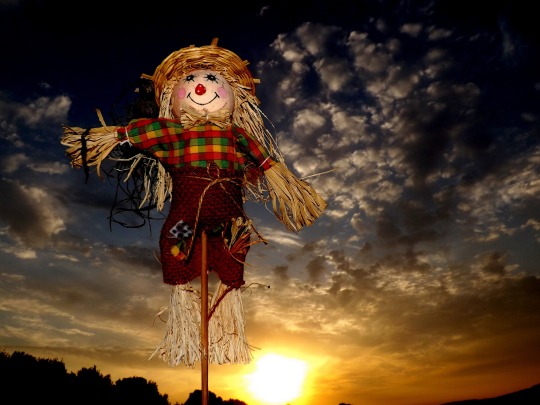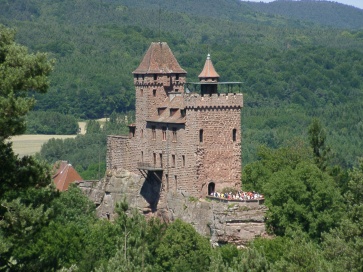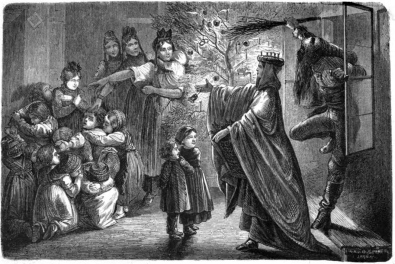Happy holidays, everyone! To celebrate the season, let’s talk about a flesh-eating scarecrow that sometimes maybe hangs around with Santa Claus.

Flawless execution.
Hans von Trotha (who now is better known as Hans Trapp) was a real 15th-century figure who lived on the woodland border between Germany and France. He was six and a half feet tall–which is tall even now, but at the time was near monstrous–and had a reputation for being kind of salty.
A high-ranking official gifted Hans two castles. The first was a piece of uninhabitable junk, but the second was Berwartstein, an impressive fortress on a hill. Berwartstein technically belonged to a nearby monastery, but Hans didn’t care. He loved the castle and hated the monastery’s abbot from a previous dispute over a church fine. So Hans accepted the gift and moved in, essentially giving the abbot a giant middle finger.
So was born a conflict that would end with Hans becoming a boogeyman on par with Krampus.
Hans Trapp: The Monster
I’ll tell you the mythology first. The story goes that Hans became greedy and power-hungry to the point of being insatiable–he even made deals with the devil to consolidate his wealth. When the church found out the extent of his godlessness, they excommunicated and put sanctions on him.
Hans retreated into the woods, where the solitude (and his growing dependence on Satanism) drove him slowly insane. Along with insanity came the desire to feast on human flesh, specifically (because this is a Christmas story!) the flesh of children.

Just trying to blend in.
Hans concocted a brilliant plan to trap his first child: He would disguise himself as a scarecrow and lay in wait in a nearby field. Passing children would never realize who he was until it was too late.
Sure enough, before long a 10-year old boy came wandering past, oblivious to the presence of a madman under the stuffed shirt and straw. Hans stabbed him with a stick and then merrily carried him back into the woods, where he salted and roasted him. Hans was just lifting the first bite to his lips when a lightning bolt shot out of the sky and into his skull, killing him on the spot. God had had enough of his crap.
Coincidentally, Santa Claus happened to spring up in the same area around the same time. Santa took on silly, reanimated Hans Trapp as a helper–one who would not-so-subtly reinforce the dangers of being naughty. Now Hans travels with Santa each year, always reaching for–but never quite getting–that first bite of flesh he so badly desires.
Hans von Trotha: The Legend

The sexy castle everyone was fighting over.
If you’re like me, you got caught on Hans’s property tiff with the church, and then called B.S. when suddenly there were stories about him being a flesh-hungry Satanist. Of course it would be in the abbot’s interest to spread stories like that–he was pissed off that Hans had taken over his castle. It’s a throwing around of political power so that you hear about so often in history that it borders on becoming stereotypical.
So what actually happened?
It turns out that while (perhaps) not being a flesh-eating monster, Hans was still a dick of legendary status–enough to make everyone even outside of the church hate him. Not only did he refuse to give ground to the monastery that had once owned his castle–he built extra fortifications on it, and then, when the conflict reached its head, dammed the river leading to the town the monastery was in, completely depriving it (and all of the innocent townspeople) of water.
The abbot complained, and complained again, and then finally Hans said “careful what you wish for” and unleashed the water without warning, completely flooding the town and devastating it economically.
So there was no love lost between the townspeople and Hans. It was even said that he was a “robber baron”–a landowner that would tax roads inappropriately and kidnap people for ransom. By the time the abbot escalated the fight to the pope and Hans was excommunicated and sanctioned, the townspeople might have been a step away from storming the castle themselves with torches and pitchforks.

Hans Trapp coming through the window like a creep.
Hans survived the sanctioning, however, and died of natural causes in the walls of his beloved Berwartstein less than a decade later. The excommunication was posthumously lifted, but the townspeople didn’t fear him any less. In addition to the scarecrow Hans Trapp legend, they cast him as a “Black Knight” (not the Batman kind) whose spirit restlessly wandered the forest hills. They also passed around a story about him trying to rape an innocent virgin.
What I’m trying to say, I guess, is that even if things get a little tense between you and your neighbors this holiday season, do your best to de-escalate. You don’t want a little argument over who gets the best seat on the sofa to end in an accusation of eating babies.
Who would win in an epic rap battle: Krampus or Hans Trapp? Share your opinions in the comments below.
IMAGE CREDIT GOES TO: AdinaVoicu on Pixabay for the scarecrow sunset; Ji-Elle (of Wikimedia Commons) for Hans in the corner, and Ulli1105 (also of Wikimedia Commons) for the castle shot. The last fantastic illustration (or print?) is courtesy of the public domain. Featured image by Yaroslav Boshnakov.





0 Comments
Trackbacks/Pingbacks